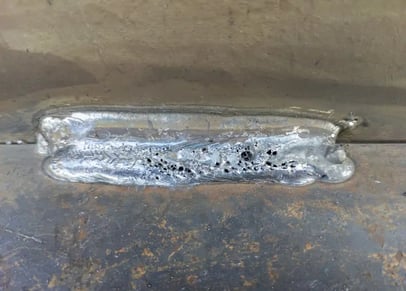How to Recognize What is Porosity in Welding and Improve Your Strategy
How to Recognize What is Porosity in Welding and Improve Your Strategy
Blog Article
Porosity in Welding: Identifying Common Issues and Implementing Best Practices for Prevention
Porosity in welding is a pervasive concern that often goes undetected till it causes substantial issues with the honesty of welds. This common issue can endanger the toughness and longevity of bonded frameworks, posturing safety and security threats and bring about pricey rework. By recognizing the origin triggers of porosity and carrying out efficient prevention strategies, welders can significantly improve the top quality and integrity of their welds. In this conversation, we will explore the key factors adding to porosity development, analyze its detrimental effects on weld performance, and review the very best methods that can be embraced to reduce porosity occurrence in welding procedures.
Common Reasons For Porosity

Another constant offender behind porosity is the visibility of pollutants externally of the base metal, such as oil, oil, or rust. When these pollutants are not effectively eliminated prior to welding, they can vaporize and end up being trapped in the weld, triggering issues. Additionally, making use of dirty or wet filler products can introduce pollutants right into the weld, adding to porosity concerns. To reduce these usual reasons for porosity, complete cleaning of base metals, appropriate securing gas selection, and adherence to ideal welding criteria are important methods in attaining top quality, porosity-free welds.
Effect of Porosity on Weld High Quality

The visibility of porosity in welding can dramatically jeopardize the architectural honesty and mechanical residential or commercial properties of welded joints. Porosity produces spaces within the weld metal, compromising its general stamina and load-bearing capacity. These voids serve as tension concentration points, making the weld more susceptible to cracking and failure under used lots. In addition, porosity can minimize the weld's resistance to rust and various other ecological elements, additionally reducing its longevity and performance.
Welds with high porosity degrees tend to display lower effect stamina and reduced capability to deform plastically prior to fracturing. Porosity can restrain the weld's ability to effectively send forces, leading to premature weld failure and prospective safety threats in important frameworks.
Ideal Practices for Porosity Avoidance
To boost the architectural integrity and high quality of bonded joints, what particular actions can be executed to lessen the occurrence of porosity during the welding procedure? Porosity avoidance in welding is essential to make sure the honesty and strength of the final weld. One reliable practice appertains cleansing official site of the base steel, getting rid of any pollutants such as corrosion, oil, paint, or dampness that could result in gas entrapment. Making sure that the welding tools is in good condition, with tidy consumables and proper gas circulation rates, can also substantially reduce porosity. Additionally, keeping a stable arc and managing the welding criteria, such as voltage, existing, and travel rate, helps create a consistent weld swimming pool that decreases the danger of gas entrapment. Making use of the correct welding technique for the particular material being welded, such as changing the welding angle and gun setting, can even more stop porosity. Routine assessment of welds and prompt removal of any kind of problems determined throughout the welding process are necessary methods to stop porosity and generate top notch welds.
Value of Proper Welding Methods
Applying appropriate welding strategies is paramount in making sure the architectural integrity and high quality of bonded joints, building upon the foundation of efficient porosity avoidance measures. Extreme warmth can lead to enhanced porosity due to the entrapment of gases in the weld swimming pool. Additionally, utilizing the proper welding criteria, such as voltage, current, and travel speed, is critical for achieving sound welds with very little porosity.
Moreover, the selection of welding process, whether it be MIG, TIG, or stick welding, should line up with the certain needs of the task to ensure optimal results. Appropriate cleansing and prep work of the base steel, along with choosing the ideal filler product, are additionally crucial parts of proficient welding methods. By sticking to these best methods, welders can decrease the threat of porosity development and generate high-quality, structurally learn this here now sound welds.

Testing and Quality Assurance Steps
Quality assurance procedures play an essential duty in verifying the stability and dependability of bonded joints. Checking treatments are important to find and stop porosity in welding, ensuring the stamina and resilience of the end product. Non-destructive screening techniques such as ultrasonic testing, radiographic screening, and visual evaluation are commonly employed to identify potential defects like porosity. These techniques permit the assessment of weld quality without compromising the integrity of the joint. What is Porosity.
Post-weld assessments, on the various other hand, evaluate the last weld for any problems, consisting of porosity, and confirm that it satisfies defined standards. Executing my explanation a thorough quality control plan that consists of thorough testing treatments and examinations is critical to minimizing porosity concerns and ensuring the general high quality of bonded joints.
Conclusion
To conclude, porosity in welding can be a typical concern that influences the quality of welds. By determining the typical root causes of porosity and carrying out best methods for avoidance, such as correct welding strategies and screening measures, welders can guarantee excellent quality and trustworthy welds. It is vital to prioritize prevention techniques to reduce the incident of porosity and preserve the honesty of bonded frameworks.
Report this page